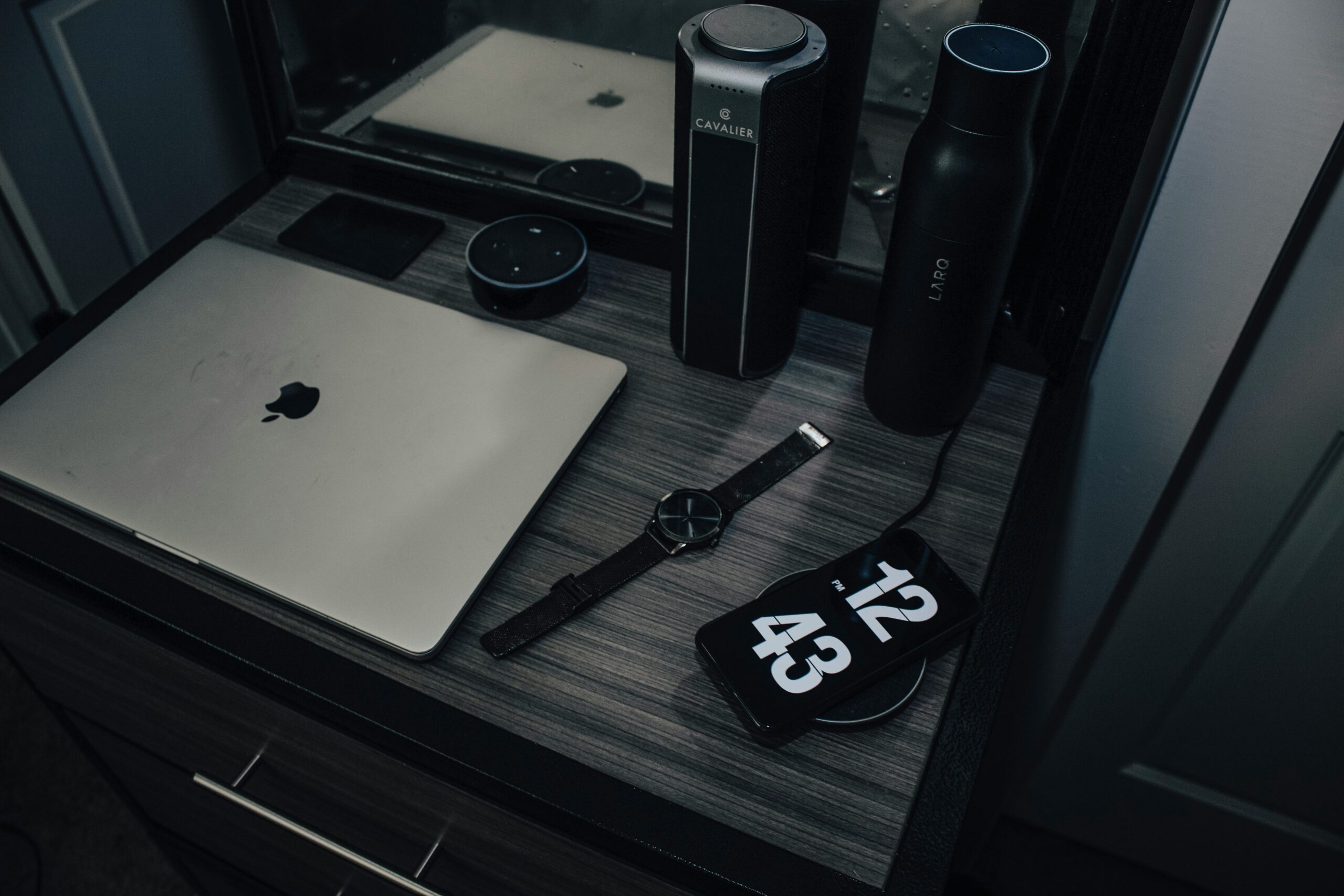Introduction to Smartwatches and Their Benefits for Seniors
Smartwatches represent an innovative intersection of technology and wearable convenience, functioning as both timepieces and multifunctional devices. Essentially, they are wrist-worn computers that connect to smartphones, allowing users to receive notifications, track health metrics, and communicate easily. These devices have gained popularity among various demographics, particularly seniors, who can greatly benefit from their unique features.
One of the primary advantages of smartwatches for disabled veterans and seniors is their capacity for enhanced communication. With a smartwatch, individuals can receive messages, calls, and alerts directly on their wrist, eliminating the need to fumble with a smartphone. This feature proves invaluable not only for staying connected with family and friends but also for managing appointments and reminders, fostering independence and social interaction among older adults.
Beyond communication, smartwatches are equipped with various health-monitoring capabilities. They can track vital signs such as heart rate, blood pressure, and even sleep patterns, providing users with comprehensive insights into their overall health. For disabled veterans, features like fall detection can alert emergency services if an incident occurs, ensuring timely assistance and promoting peace of mind for both the individuals and their loved ones.
Fitness tracking is another significant benefit offered by smartwatches. Many devices come with step counters, activity reminders, and guided exercise routines tailored for seniors. These features encourage physical activity, helping users maintain mobility and overall well-being. The gamification aspect of fitness tracking can make exercise more enjoyable, fostering a sense of accomplishment.
Moreover, with the increasing acceptance of technology in everyday life, smartwatches are becoming more user-friendly. Many brands design their interfaces to be intuitive, ensuring that seniors can navigate without difficulty. As a result, the growing trend of smartwatch adoption among older adults reflects a shift towards a tech-savvy approach to enhancing their quality of life.
Key Features to Look for in Smartwatches for Seniors
When selecting a smartwatch for seniors, it is crucial to prioritize features that enhance usability, accessibility, and health monitoring. A large, easy-to-read display is fundamental, as many seniors may experience visual impairments. A display that offers high contrast and adjustable font sizes can significantly improve readability, thus allowing seniors to interact comfortably with the device.
Equally important is a simple user interface. Complicated navigation can lead to frustration, so a streamlined design that emphasizes basic functions and large icons is essential. Furthermore, incorporating voice control capabilities can provide an additional layer of accessibility, enabling seniors to operate the watch without needing to navigate manually. This feature is particularly beneficial for those with limited dexterity or visual challenges.
Another significant aspect to consider is customizable alerts tailored to the individual’s specific needs. For instance, reminders for medication can prove invaluable for seniors managing multiple prescriptions. Additionally, alerts for appointments or daily activities can help maintain organization and provide a sense of routine.
Health and fitness monitoring functionalities are indispensable in smartwatches for seniors. Devices equipped with heart rate tracking can help monitor cardiovascular health, while sleep monitoring features can provide insights into sleep quality, which is vital for overall well-being. Moreover, advanced technologies such as fall detection can alert caregivers or emergency services if a fall occurs, ensuring timely assistance.
Finally, medication reminders are a critical feature that can support adherence to health regimens. By integrating technology for disabled veterans who may encounter challenges in their daily lives, these smartwatches can facilitate independence and improved health outcomes for seniors. Selecting a smartwatch with these essential features can significantly enhance the quality of life for elderly users, ultimately assisting them in managing their health more effectively.
Top Smartwatch Brands and Models for Seniors
When considering a smartwatch for seniors, it is essential to select from brands and models that prioritize usability, accessibility, and reliability. Here is a curated list of some of the most recommended smartwatches that cater specifically to older adults.
Apple Watch Series 8: The Apple Watch Series 8 stands out for its user-friendly interface and robust health features. It includes heart rate monitoring, fall detection, and even an ECG app. The display is clear and vibrant, making navigation straightforward for seniors. However, the price can be on the higher side, ranging from $399 to $749, depending on the model and features selected.
Samsung Galaxy Watch 5: Known for its sleek design and comprehensive features, the Galaxy Watch 5 includes fitness tracking, heart rate monitoring, and blood oxygen levels. Its battery life is another strong point, lasting up to 40 hours on a single charge. The approximate price is between $279 and $329, positioning it as a mid-range smartwatch option.
Fitbit Versa 4: The Fitbit Versa 4 focuses on health and fitness while maintaining a simple interface. Key features include sleep tracking and over 40 exercise modes, making it a solid choice for active seniors. The price is relatively lower, ranging from $199 to $229, enhancing its appeal for those on a budget.
Garmin Venu Sq 2: The Garmin Venu Sq 2 offers a range of health monitoring tools, including stress tracking and guided breathing exercises. Known for its long battery life and ruggedness, it is a practical choice for seniors who enjoy outdoor activities. Its price usually falls between $199 and $249.
Choosing the right smartwatch for seniors hinges on finding a balance between functionality and ease of use. These recommended brands and models not only demonstrate user-centric designs but also promise reliability and excellent customer support, making them suitable companions in daily life.
Comparing Smartwatches to Traditional Watch Options
When it comes to choosing a timepiece, seniors often face the decision between traditional watches and the more modern smartwatches. While traditional watches serve the fundamental purpose of telling time, they fall short in offering additional functionalities that can significantly enhance the daily lives of seniors. One of the primary advantages of smartwatches is their multifaceted capabilities, which extend far beyond timekeeping. These devices are specifically designed to integrate technology for disabled veterans and older adults who may have specific needs.
Smartwatches are equipped with health monitoring features that enable users to track vital signs such as heart rate, activity levels, and even sleep quality. This can be particularly beneficial for seniors who may have chronic conditions or those wanting to maintain an active lifestyle. In contrast, traditional watches provide no such health insights and lack the interactivity that comes with smart technology.
Another significant advantage of smartwatches is their emergency messaging capability. With features like fall detection and emergency contact alerts, they provide an added layer of security, enabling seniors to reach out for help quickly should they require assistance. Traditional watches do not offer such safety features, often leaving seniors vulnerable in emergency situations.
Moreover, smartwatches facilitate social connectivity, allowing seniors to receive calls, messages, and notifications right on their wrists. This connectivity can help counter the isolation that some elderly individuals experience, encouraging more interaction with friends and family. Traditional watches, while often stylish, lack this level of engagement and social integration.
In essence, for tech-savvy seniors or those who have adapted to living with disabilities, the advanced functionalities of smartwatches present a compelling case for consideration over traditional watch options. As we continue to explore the advantages of smartwatches, it becomes evident that their features cater more effectively to the needs of today’s elderly population.
Understanding the Costs: Are Smartwatches Worth the Investment?
When considering the purchase of a smartwatch, it is essential to evaluate both the initial costs and the potential long-term benefits associated with this technology. Smartwatches come in a wide price range, typically starting from around $50 for basic models and extending up to $1,000 or more for advanced devices featuring comprehensive health monitoring capabilities and connectivity options. In addition to the purchase price, many smartwatches may require accompanying subscription models for premium features such as health tracking, emergency services, or enhanced software updates. These subscriptions can vary in cost, and it is critical for buyers to budget accordingly.
The financial implications of investing in a smartwatch must be assessed in light of the potential savings and increased well-being it can deliver to seniors. For instance, smartwatches equipped with health-monitoring capabilities can track vital signs, remind users to take medications, and even alert caregivers or medical professionals in case of emergencies. This proactive approach to health management can lead to significant reductions in healthcare costs by promoting early detection of health issues. By using technology for disabled veterans, these devices can also enhance the quality of life for those with specific health challenges or mobility issues.
Furthermore, the independence and security that a smartwatch can provide are invaluable. Many models come with fall detection and SOS features, ensuring that help is readily available when needed. The emotional and psychological impact of knowing that one has a reliable tool to monitor their health and safety cannot be overstated. Hence, even with a higher upfront cost, the value of improved health management and enhanced quality of life can justify the investment.
In the context of evaluating smartwatches, it becomes clear that although the initial expenses may seem daunting, the lasting benefits both financially and in well-being far outweigh these concerns. As consumers consider the purchase of a smartwatch, understanding the costs alongside the advantages will be pivotal in making an informed decision.
Getting Started with Your Smartwatch
For seniors, embracing new technology can be a significant leap, but with a few practical steps, navigating a smartwatch becomes manageable and enriching. First and foremost, setting up the device is an essential initial step. Most smartwatches come with a user manual that provides clear instructions tailored to new users. However, for additional support, online resources such as instructional videos can be beneficial. These videos often provide visual walkthroughs, making it easier to follow along and understand the setup process.
Once the smartwatch is powered on, it is crucial to personalize its settings according to individual preferences. Seniors should explore options like adjusting the font size for better visibility, customizing notification settings, and selecting health or fitness tracking features that are relevant to their lifestyle. Tailoring the smartwatch not only enhances usability but can also motivate seniors to engage with technology for disabled veterans, leading to increased independence and connectivity.
Navigating the smartwatch features can initially feel overwhelming; however, a gentle approach can facilitate learning. Seniors are encouraged to take their time exploring functionalities such as health monitoring, messaging, and calendar notifications. Frequent usage will increase comfort levels and familiarity with the watch. In case of challenges, troubleshooting common issues can typically be achieved through the watch’s help section or by consulting the manufacturer’s support page.
For those looking to deepen their understanding, joining community classes or technology workshops designed for seniors can provide valuable insights and tips. Engaging with peers who are at a similar learning stage fosters a supportive environment, promoting confidence and shared experiences. By taking these steps, seniors can fully embrace the advantages offered by smartwatches, making technology for disabled veterans and seniors an effective tool for enhancing daily life.
Success Stories: How Smartwatches Have Helped Seniors
Across the globe, numerous seniors have found renewed vitality through the integration of smartwatches into their daily routines. These devices have transcended their initial function of merely telling the time, emerging as powerful tools that promote health, security, and social connectivity. Let’s explore some inspiring testimonials from seniors who have experienced significant benefits from these technological advancements.
One notable story is that of Margaret, a 72-year-old grandmother who struggled with chronic health issues. After receiving a smartwatch equipped with health monitoring features, Margaret learned to track her heart rate, blood pressure, and daily activity levels. With this technology for disabled veterans, she was able to share important health data directly with her healthcare provider. This facilitated timely interventions and transformed her approach to health management, ultimately leading to improved well-being and more active participation in family gatherings.
Another impactful account involves John, an 80-year-old veteran living alone in a suburban area. John initially hesitated to adopt new technology, but his family gifted him a smartwatch with emergency call functions. One evening, he experienced a fall in his home. Thanks to the device, he was able to send an alert to emergency services. The swift response from medical professionals not only ensured his prompt recovery but also reinforced his family’s confidence in the technology. This experience allowed him to feel more secure living independently.
Finally, there’s the inspiring journey of Ellen, a 68-year-old who lives far away from her children. After using a smartwatch with social connecting features, she found joy in video calling her grandchildren regularly. The ease of communication kept familial bonds strong and enriched her social life. The introduction of technology for disabled veterans also dramatically alleviated her feelings of isolation, showcasing how smartwatches serve to enhance the quality of life for seniors, fostering greater independence and reducing health anxieties.
These stories reflect the growing trend of seniors embracing technology in meaningful ways. The benefits of smartwatches resonate deeply, illustrating not just the immediate advantages but also long-term positive influences on overall health and well-being.
Addressing Common Concerns about Smartwatch Usage Among Seniors
As the integration of technology into daily life becomes increasingly prevalent, many seniors may experience apprehension regarding the adoption of smartwatches. Common concerns include technological anxiety, privacy issues, and usability fears. However, it is essential to understand that smartwatches are designed with user-friendliness in mind, specifically to cater to the needs of various age groups, including seniors. This section aims to reassure older adults about these concerns while highlighting the advantages of incorporating technology for disabled veterans and seniors alike.
Technological anxiety is a prevalent issue among older adults who may feel overwhelmed by the rapid advancements in technology. Smartwatches typically come equipped with simplified interfaces, intuitive controls, and settings that can be tailored to individual preferences. Many models offer guided tutorials or customer support specifically aimed at helping seniors navigate the basic functionalities, making the transition into using these devices less daunting. This enhancement in accessibility ensures that seniors can confidently engage with technology, fostering independence and empowerment.
Privacy and security concerns are also common among potential smartwatch users. It is crucial to note that reputable brands prioritize user privacy by implementing robust security features. Many smartwatches allow users to customize privacy settings, enabling them to control the data that is shared and stored. Furthermore, encryption technology is often employed to safeguard personal information, enhancing peace of mind for seniors using technology for daily activities. These measures demonstrate a commitment to protecting user data while allowing seniors to benefit from features that monitor health, simplify communication, and provide connectivity to family and friends.
Lastly, usability remains a significant concern. However, most modern smartwatches are equipped with larger text options, voice command capabilities, and even emergency SOS features catering specifically to seniors. By addressing these concerns, it is clear that smartwatches can be an invaluable tool, enhancing daily living while addressing the unique needs of older adults without compromising their safety or comfort.
Looking Ahead: The Future of Smartwatches for Seniors
The landscape of technology for seniors, particularly smartwatches, is rapidly evolving, promising exciting advancements that cater specifically to the needs of older adults. As we look ahead, it is essential to explore the anticipated trends that will shape the future of these devices, making them even more beneficial for senior users.
One of the most significant areas of development is health monitoring. Current smartwatches already offer basic features such as heart rate tracking and step counting; however, future iterations are expected to incorporate more sophisticated health metrics. Innovations like continuous glucose monitoring and advanced fall detection are on the horizon, which will provide seniors and their caregivers with real-time health insights. By integrating technology for disabled veterans or seniors managing chronic conditions, these enhancements may significantly improve quality of life and promote timely intervention in critical situations.
Artificial intelligence (AI) is another groundbreaking technology anticipated to play a vital role in smartwatches designed for seniors. With the ability to learn user habits and health patterns, AI-driven smartwatches can offer personalized recommendations and even alert caregivers when anomalies are detected. This proactive approach will empower seniors to take charge of their health while ensuring that support systems are in place when needed.
Integration with smart home devices is also a key trend that manufacturers are focusing on. Future smartwatches will likely interact seamlessly with various home automation systems, allowing seniors to control lighting, security, and appliances directly from their wrists. This interconnectedness not only enhances convenience but also creates a safer living environment for older adults.
As technology continues to advance, it is evident that smartwatches for seniors will undergo significant improvements, making them indispensable tools in enhancing independence, health management, and overall well-being. By prioritizing the specific needs of older adults, the evolution of these devices will ensure they remain relevant and highly functional in the years to come.



